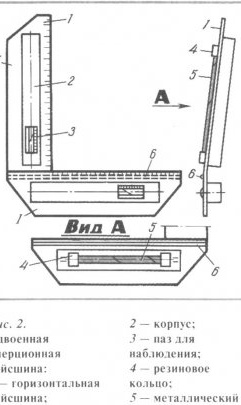Home page
1. Drawing board.
2. Drawing inertial tire.
3. Stencils for dashed lines.
4. Fixture for building tangents and normals to curved lines.
5. How to divide a line and a circle into equal and unequal parts.
Inertial Drawing Tire.
Everyone who deals with drawing instruments knows the inertial raiser. This is a very convenient and accurate tool that allows you to draw parallel lines, and the desired distance between the lines helps to set the inertial shaft on which the helical risk is applied.
However, with such a raiser, it is possible to apply parallel lines in only one direction (either vertical, horizontal, or inclined) without rearrangement.
But what if we connect two standard inertial rails at an angle of 90 ° to each other and thus ensure that we use mutually perpendicular lines with a “double” raiser?
A similar “double” inertial treadmill is shown in Fig. 2. Each T-square (I and II) consists of a base, a body with a groove, and also a metal roller with a screw flange and rubber rings. The roller is fixed in bearings mounted in the housing of the tine. Thanks to the rubber rings (or knurling), the roller has good adhesion to the paper and rolls along the latter “quite parallel”, which allows you to draw parallel lines.
Click to enlarge.
So, we fix the rails I and II perpendicular to each other (it's easy!). But we will install them not in the same plane, but in such a way that if we place the I rail on the board, then the far end of the II rail will rise a little up. And we will also form a flange on the I rail, placing it along the axis of the raiser.
Improved rashina works as follows. To obtain horizontal lines, we press the I-rail to the sheet and, moving it from ourselves and to ourselves, draw horizontal lines. In this case, only rubber rings of the roller of the I-raiser I will be in contact with the paper. to move freely.
When drawing vertical lines, the raiser II is pressed against the paper, as a result of which the raiser I rotates relative to the shoulder, that is, it becomes like on an edge. In this way, the rubber rings of Ripper II come into contact with the paper, while the rings of Ripper I move away from the paper.In this position, the lintel I can be moved left and right with the aim of drawing vertical lines in different places of the paper (the friction of the collar against the paper does not interfere with the movement of the vane).
When changing the position of the taper against the sheet of paper, the perpendicularity of the drawn lines is observed quite accurately.
Content:
Home page
1. Drawing board.
2. Drawing inertial tire.
3. Stencils for dashed lines.
4. Fixture for building tangents and normals to curved lines.
5. How to divide a line and a circle into equal and unequal parts.

